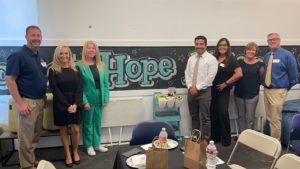How Do We End Generational Homelessness? Start With Our Kids.
by Jennifer Friend, Chief Executive Officer, Project Hope Alliance
I am a proud HB Oiler, class of 1988. I attended Dwyer, had dances in the city gym, competed in MUN (Model United Nations) conferences, and also experienced homelessness with my family on and off from 7th – 12th grade. My dad was a technology entrepreneur before the world believed we’d all be carrying around our phone/personal computers in our pockets and we went from living in Seacliff to the Tropic Motel.
Gratefully, homelessness was only a chapter in my story which included others like community college, graduating from UCI, going on to law school, and becoming a litigation partner at a large firm. Ultimately, the storyline found me serving as the CEO of Project Hope Alliance, an Orange County nonprofit that fills in the gaps and eliminates the barriers that homelessness causes in the lives of our community’s kids that prevent them from knowing that anything is possible for them. By showing up for our kids in real time and coming into their lives and directly onto their public school campuses in Huntington Beach, Westminster, Fountain Valley, Newport Mesa, and Santa Ana we are ending the cycle of homelessness, one child at a time.
In May of 2023, the Orange County Grand Jury issued the report “The ABC’S of Educating Children Experiencing Homelessness in Orange County”. This report marks a turning point for our kids in our county, and possibly our country. Most importantly the report finds that the true count of how many students there are experiencing homelessness in Orange County is found by using the McKinney -Vento definition of homelessness used by America’s public school system. Under this definition, a child is deemed homeless if they “lack a fixed, regular, and adequate nighttime residence” due to economic hardship. This includes children and youth residing in motels, shelters, sleeping cars, couch surfing and living in doubled and tripled up conditions. According to the Orange County Department of Education, 23,246 students were identified as experiencing homelessness during the 2022 school year by the twenty-eight school districts in the county (though the Grand Jury Report found the actual number of students to be closer to 30,000).
The report went on to find that children raised in homelessness have “higher absenteeism rates, lower literacy rates, and a more limited vocabulary with 70% unable to meet state standards on state-mandated tests. In Orange County, less than 35% of all homeless students in public schools Met or Exceeded State Standards in English Language Arts, less than 25% Met or Exceeded State Standards in math, and they graduate at lower rates than average.” It also found that currently insufficient resources have been allocated in Orange County to meet the needs of children experiencing homelessness.
In its 2020 report, State of Crisis: Dismantling Student Homelessness in California, the UCLA Center for the Transformation of Schools reported nearly 270,000 K-12 students in CA experienced homelessness in the 2018-19 school year, enough to fill Dodgers Stadium 5 times. These students represent approximately 4% of all CA K-12 students, and they are disproportionately students of color. And these are pre-pandemic numbers.
Students experiencing homelessness (if they can overcome the transportation barrier) come to school struggling to eat, sleep, live outside of the shell of fear, and to find their way amidst their peers while struggling with feelings of isolation and shame. These barriers can seem insurmountable. Uniquely though, the school campus is where the students are and serves as an ideal location to meet their needs.
Project Hope Alliance brings highly skilled trauma-informed case managers onto school campuses full-time. We embed ourselves into the campus culture. Case managers are visible and approachable on campus. We join all staff meetings and are viewed as part of the campus team. Teachers and staff may note signs of housing insecurity: a student’s spotty attendance, poor academic performance, arriving on campus early to wait in line for food, or showering in the gym. When they see the signs, school staff now have a resource for immediate referral and assistance in real-time. Our case managers attend meetings related to suspensions, chronic absenteeism, and behavioral issues (for which homeless students are disproportionately penalized) as they occur, providing an advocate for the student and solution partner for the school. With a 30:1 student-case manager ratio, we are able to make transformative and trauma-informed work possible.
Last year 100% of the students served by Project Hope Alliance graduated high school (more than 25% above the national average for students experiencing homelessness) making them 346% less likely to experience homelessness as an adult resulting in a projected community savings of $14.3 million by 2030.
This work is time, labor, and cost-intensive, but transformational. We have been able to witness students flourish in the classroom and beyond. Together, we can ensure that students experiencing homelessness today are not adults experiencing homelessness tomorrow. We have the resources available to expand this program onto every campus in Orange County. We just need the will. Let’s join together for the kids and end generational homelessness.
Pictured above: Jennifer Friend with members of the Huntington Beach School District

